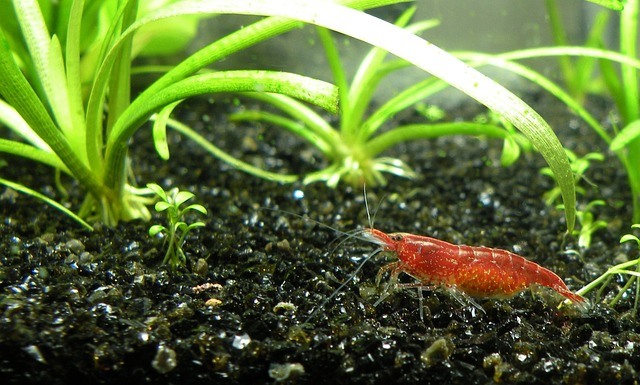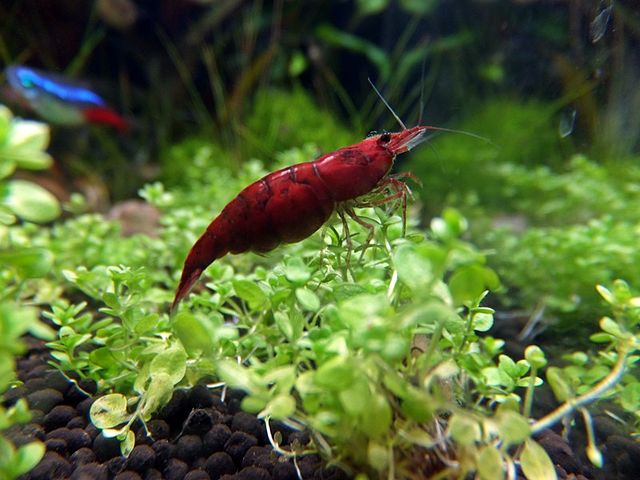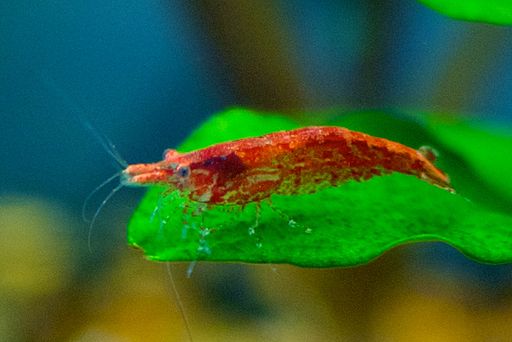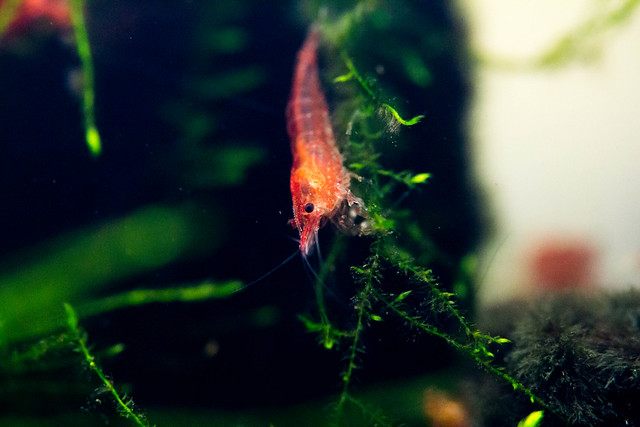If you’re seeking a new freshwater species to add a vibrant dash of color to your tank, look no further than the red cherry shrimp!
Their bright red color will definitely stand out against your green aquarium plants and grainy substrate. As a plus, they’re a natural tank-cleaning creature, ideal for those who need extra help maintaining a pristine aquarium.

Keeping a cherry shrimp tank is easier than you might think! This guide will cover the origin of this shrimp species, as well as all the basics of red cherry shrimp care.
Ready to own one of these interesting creatures? Let’s dive in.
Contents
What Are Cherry Shrimp?
Cherry shrimp (scientifically referred to as the ‘Neocaridina davidi variation red’ or the ‘Neocaridina heteropoda variation red’) are a type of dwarf shrimp that are mainly found in the freshwater pools and streams of Taiwan, China, and other parts of Asia.
There is some debate on whether they prefer slow-moving streams over faster-flowing ones, but this species can be found in both types of water.
They may also be referred to as the red cherry shrimp, fire shrimp, or the sakura (which is Japanese for ‘cherry blossom’) shrimp. The lifespan of most cherry shrimp is roughly around one to two years.
It is impossible to tell the difference between male and female cherry shrimp when they are young. However, as they mature, a female will develop an orange saddle on her stomach. This saddle is used to hold her eggs before they are fertilized.
The biggest cherry shrimp size is about an inch or two at the most, with females usually being larger than males. Females also tend to have brighter colors than their male counterparts.
A cherry shrimp’s bright coloration is mostly due to years of selective breeding from shrimp that were originally far browner in color.
Not all cherry shrimp will have the exact same level of coloration, so you can pick and choose between intense or tame shades.
Grading System
Expert shrimp breeders are always working to produce shrimp that are even more intensely red than their last batch.
This has led to the establishment of a grading system, which assesses a shrimp’s overall color quality. Typically, the more opaque and intense the red coloration is, the higher the grade of cherry shrimp.
This grading system ranks cherry shrimp from the deepest red to paler shrimp with red spots. The lowest grade of cherry shrimps is simply referred to as the regular cherry shrimp. These are mainly clear in color with some red patches.
Above that is the sakura cherry shrimp, which is slightly redder in color than regular cherry shrimp – but they will still have clear patches. Next up is the fire-red shrimp, which is the grade of cherry shrimp that is entirely red.

Finally, you have the most expensive and highest grade of cherry shrimp—the painted fire-red shrimp. They are a solid, deep-red color with no transparent areas whatsoever.
Strict selective breeding can result in more intensely colored shrimp, but if you let a colony breed too freely, their intense reds will start to fade in future generations.
Though the most famous cherry shrimps are red in color, they actually come in a wide range of colors. A cherry shrimp can be yellow, orange, green, blue, violet, black, or any other color you can think of. Red cherry shrimps are just sold most frequently.
Price
This species is relatively cheap to own as pets. Even the most expensive grade of cherry shrimp rarely ever goes over $6 at the most.
Petco sells cherry shrimp for about $2.79 per shrimp, while other sites online, like Aquaticarts, sell several packs of shrimp at varying prices.
Cherry Shrimp Care
Cherry shrimp are very active fish and are often busy during both the day and night. Most of their routine is spent grazing on whatever is in your aquarium, including plants, moss, and other substrates.
They are also quite hardy compared to other types of shrimp, making them very easy to care for.
They are simple to breed, maintain, and will naturally hide from any potential predators they may share a tank with. Altogether, you don’t have to worry about them much.
This video goes into more detail on cherry shrimp.
How to Set Up a Cherry Shrimp Tank
Tank Size
You don’t need to keep red cherry shrimp in a large aquarium. A set-up of at least five gallons (or 19 Liters) should be more than enough to sustain a decent-sized colony.
Some aquarists will even house them in smaller tanks, but these are far more difficult to keep stable and are thus much harder for beginners to maintain.
Your shrimp will feel safest when given plenty of areas to explore, as well as hiding places all throughout their aquarium.
These special hiding places can be made from anything, including live plants or special shrimp tubes.
Water Temperature
Red cherry shrimp should be kept in water that is around 77 to 81 degrees Fahrenheit (or 25 to 27 degrees Celsius). These higher temperatures will lead to faster growth and reproduction rates.
However, keep in mind that higher temperatures will also reduce dissolved oxygen, and stocking will need to be lowered.
The highest temperature that cherry shrimp can tolerate is 86 degrees Fahrenheit (or 30 degrees Celsius), but the water needs to be aerated and the tank can’t be too overstocked if it does reach this temperature.
These shrimps can survive temperatures lower than 77 degrees Fahrenheit, but they are unlikely to breed and will have a higher chance of catching diseases.
Water Requirements
pH
The water’s pH level should range between 6.2 and 7.3 to enhance health, color intensity, and egg-hatching rates.
If you have higher pH, you should use a commercial substrate, similar to ADA Amazonia, to lower the pH. Also be sure to provide a soft, dark substrate for your shrimp to hide in.

You can add a small bag of peat to your filter to naturally bring down the pH, but this may discolor the water in your tank.
Nitrite and Ammonia
The nitrite and ammonia in your tank should be 0 ppm after you cycle your water.
Shrimp are highly sensitive to both nitrite and ammonia, so you must ensure there is absolutely neither of those things in your water when you test it again.
Nitrate
Try to keep your nitrates less than 20 ppm. If the nitrate levels go above 20 ppm, your shrimp become more susceptible to disease and infertility.
If possible, keep your tank’s nitrate levels at 0 ppm. Adding live plants to your aquarium and doing constant water changes can easily reduce those pesky nitrates levels down to the optimal levels.
Flow Rate
Cherry shrimp seem to be the most comfortable in established aquarium water that is on the hard side, with a decent-flowing current.
The key is to keep the water conditions as stable as you can while avoiding ammonia spikes and high nitrites levels.
Tank Maintenance
You need to change 30 percent of your aquarium water at least once a week. It’s a good idea to mix a dechlorinate solution in your water changes, as red cherry shrimp are sensitive to chlorine and heavy metals.
It’s best to prepare this solution a few days before to let the water properly “age” with the solution; this ensures any potentially toxic compounds in the water are broken down and removed.
Use a spare glass heater to heat the replaced water to the aquarium’s temperature. You should also test the water for any dangerous chemicals, ensuring it is well within the parameters given above.
Remember that, although this species is hardy, they are still sensitive to severe fluctuations or rapid changes in their water chemistry. They are just as susceptible to shock from a water change as any other fish species.
Introducing the Shrimp to Your Tank
Before you add your red cherry shrimp back into your aquarium, you should first place them (from the bag you stored them in) into a large bowl.

Then, create a siphon with air-line tubing from the aquarium and a rubber band. Kink the tubing by placing the rubber band over a bent section of the tube.
Then, adjust it so that it allows a slow drip of 1 drop of water per second. Let the new water drip into the bowl for the next 20 to 30 minutes and monitor your shrimps’ behavior closely.
If they seem fine after a 20 to 30-minute interval, use a soft mesh net to transfer the shrimp into their aquarium. Be sure to cover the net with one hand while you move them. Cherry shrimp may jump and try to escape the net.
Be Careful of Filters
Be wary of using filters in your cherry shrimp tank! Most filters are too powerful and can accidentally suck up your shrimp.
Try to use a sponge filter or, if you insist on using a more powerful filter, such as a canister, use the inlets with foam to reduce its flow.
Check on your shrimp every once in a while, and make sure that the filters aren’t sucking them up! If you’re worried that less filtration won’t oxygenate your tank water, you can always use an air stone.
Cherry Shrimp Food
Cherry shrimp aren’t very picky when it comes to food. They are omnivores that are content to feed on almost any types of food they come across in the tank.
They can survive off of leftovers from other fish if they live in a community tank, or can survive on tiny particles that they find in plants and algae patches.
They will also greatly appreciate any specialized shrimp food, algae pellets, and blanched vegetables you give them. Remember to only feed them these in moderation, however. They can grow ill if over-fed.
You should feed your shrimp a small amount of food every day if they live in a single-species tank. If you notice any leftover pieces of food that haven’t been eaten within a few hours, be sure to remove them.
These leftovers can cause dangerous ammonia spikes when left in the water too long.
During feeding time, the whole colony will often flock to the food in a frenzy and eat as much as possible, so, hopefully, this won’t be a problem for you.

Cherry Shrimp Tank Mates
Dwarf shrimp are very peaceful creatures, and the red cherry shrimp is no different. While you don’t have to worry about them harming any tank mates, unfortunately, they will easily fall prey to hungry fish.
Typically, higher-grade shrimp should be kept in a single species aquarium, whereas lower-grade shrimp can be placed with other tank mates.
A cherry shrimp’s ideal tank mates include freshwater snails (mostly the ivory, mystery, gold Inca, nerite, and Malaysian trumpet varieties), catfish (the Cory and Otocinclus species), small plecos, dwarf gouramis, and small tetras.
Breeding
If you see your cherry shrimp dancing around each other after a water change or when they molt, this means that the males are chasing the females around in an attempt to breed with them.
Breeding cherry shrimp is surprisingly easy to do, which is one of the many reasons that they are extremely popular pets.
Just make sure to maintain good water quality, as well as provide them with plenty of food, and your females will be pregnant all the time.
They will lay their eggs somewhere in between 30 to 40 days after breeding with a male. You may even see pregnant females waving fresh water over their eggs in order to supply them with oxygen.
The fry is very tiny and may require some time before they develop their typical red color. They are also very vulnerable at this age, so providing the fry with several different hiding places will help ensure their survival to adulthood.
If the fry do suffer some casualties, however, your shrimp will breed fast enough to offset them.
This video explains more about breeding cherry shrimp.
Conclusion
Red cherry shrimp are some of the most vibrant freshwater fish you can own.
Their hardiness, relatively simple care and temperament make them some of the easiest fish for beginners and experts alike to care for!
What are your favorite things about cherry shrimp?


I agree with your point about sponge filters being a safer option for shrimp, but I wanted to point out that they can still get stuck in the airlift tube. I’ve had this happen with a few shrimp and, once they’re in there, it’s hard to get them out without smooshing them. Unfortunately, cherry shrimp aren’t the brightest creatures and always manage to find a way to hurt themselves. I’ve fixed this by adding a stocking (tights, whatever you want to call them) over the airlift. It doesn’t look pretty, but it works.